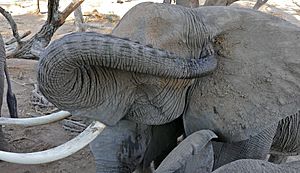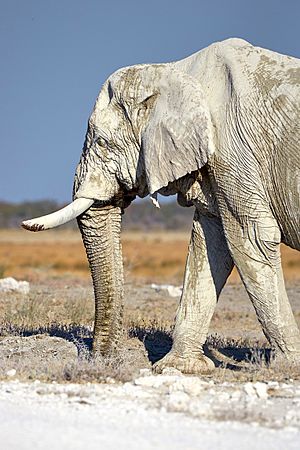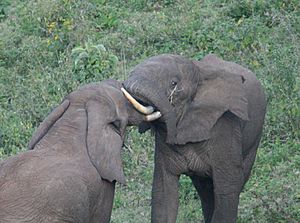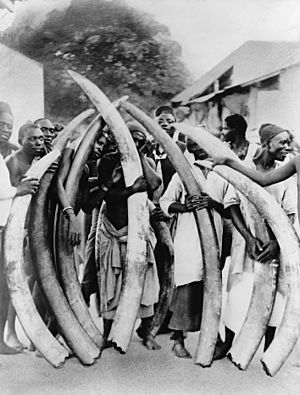African elephant facts for kids
Quick facts for kids African elephant |
|
|---|---|
 |
|
| African elephant (Loxodonta africana) in Tanzania | |
| Scientific classification | |
| Kingdom: | |
| Phylum: | |
| Class: | |
| Order: | |
| Family: | |
| Genus: |
Loxodonta
Anonymous, 1827
|
African elephants are amazing animals that belong to the group called Loxodonta. There are two main types of African elephants alive today: the big African bush elephant and the slightly smaller African forest elephant.
Contents
What are African Elephants Like?
The African bush elephant is the largest land animal alive. The forest elephant is the third largest. These elephants have strong, thick bodies and sturdy legs. Their backs curve inwards. They have very large ears that help them stay cool in hot weather.
Their upper lip and nose are joined to form a trunk. The trunk is like a fifth limb. It helps them make sounds and is important for touching things. African elephants have two finger-like tips at the end of their trunks. Asian elephants only have one.
Male African elephants can be 3.2–4.0 m (10–13 ft) tall at the shoulder. They weigh between 4,700–6,048 kg (10,360–13,330 lb). Female elephants are smaller. They stand 2.2–2.6 m (7–9 ft) tall and weigh 2,160–3,232 kg (4,762–7,125 lb). The biggest elephant ever recorded was 4 m (13.1 ft) tall and weighed 10 tonnes (10 long tons; 11 short tons).
Skin, Ears, and Trunk
African elephants have thick, grey, wrinkled skin. It can be up to 30 mm (1.2 in) thick. They have thin, bristly dark-brown or black hair on their bodies. Short, touch-sensitive hairs grow on their trunks.
Their huge ears help them cool down. When they flap their ears, it creates air currents. This also shows the inside of their ears, where many blood vessels help release heat.
The trunk is a very useful part of an elephant. It is a long, flexible extension of its upper lip and nose. This sensitive organ has many muscles, about 40,000 to 60,000! This makes the trunk very strong. Elephants can lift about 3% of their own body weight with it. They use their trunks for smelling, touching, eating, drinking, dusting, making sounds, carrying things, and even for defense. Elephants can also swim underwater and use their trunks like a snorkel.
Tusks and Teeth
Both male and female African elephants have tusks. These tusks are actually very long teeth. They start growing when calves are about one year old. Tusks are made of a material called dentin.
Elephants use their tusks for many things. They dig for roots and pull bark off trees for food. They also use them to fight each other during mating season or to defend themselves from predators.

Tusks can weigh from 23 to 45 kg (51–99 lb) and be 1.5 to 2.4 m (5–8 ft) long. They curve forward and keep growing throughout the elephant's life. Sadly, poachers often kill elephants for their tusks. This has led to more elephants being born with smaller tusks.
Elephants have four large molars (grinding teeth). Each molar weighs about 5 kg (11 lb) and is about 30 cm (12 in) long. As the front molars wear down, new ones grow in from the back of the mouth. Elephants replace their teeth about four to six times in their lives. Around 40 to 60 years old, elephants lose their last molars. When this happens, they can no longer eat properly and often die from starvation. African elephants have 24 teeth in total.
Size Differences
The African bush elephant is the biggest land animal. Female bush elephants are 2.2–2.6 m (7.2–8.5 ft) tall and weigh 2,160–3,232 kg (4,762–7,125 lb). Males are 3.2–4 m (10–13 ft) tall and weigh 4,700–6,048 kg (10,362–13,334 lb). Their backs have a concave (curved inward) shape.
The African forest elephant is smaller. Females are 1.8–2.4 m (5 ft 11 in – 7 ft 10 in) tall and males are 2.4–3 m (7 ft 10 in – 9 ft 10 in) tall. They can weigh up to 4,000 kg (8,800 lb). It is the third largest land animal.
Where Do They Live?

African elephants live in Sub-Saharan Africa. You can find them in different places like dry scrublands, tropical rainforests, and woodlands. African forest elephants mostly live in Central Africa.
How Do Elephants Live?
Sleeping Habits
Elephants sleep very little. African elephants, especially, have some of the shortest sleep times of any animal. They usually sleep for only about 2 hours in a 24-hour day.
Family Life
Both types of African elephants live in family groups. These groups include several adult females, their daughters, and their younger sons. An older female, called the matriarch, leads each family. Forest elephant groups are not as close as bush elephant groups, probably because they have fewer predators.
Sometimes, different family groups will join together to form larger bond groups. When male elephants grow up, they often form strong friendships with other males.
Elephants are very good at communicating. They use special low-frequency sounds called infrasonic calls that humans cannot hear. These calls help them talk to and identify each other over long distances. Elephant mating rituals include gently wrapping their trunks together.
It was once thought that male elephants lived alone after growing up. But new research shows that older males help the herd by remembering where to find food and water. This also helps younger males who spend time with them. Male elephants usually only return to the herd to breed or socialize. They don't help raise their babies, but they do act like fathers to younger males.
What Do They Eat?
When eating, African elephants use their trunks to pick leaves. They use their tusks to tear off branches. This can cause a lot of damage to plants. Elephants can eat many different parts of plants, including tough stems, bark, and roots. They have a special digestive system that helps them break down large amounts of food.
How Smart Are They?
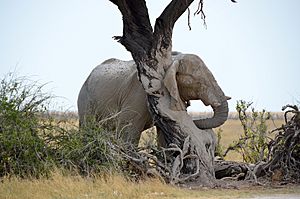
African elephants are very intelligent animals. They have a very large and complex brain, similar to humans, apes, and some dolphins. They are considered among the smartest animals in the world.
An elephant's brain weighs just over 5 kg (11 lb), making it the largest brain of any land animal. The structure of an elephant's brain is similar to a human brain. Their cortex has as many neurons as a human brain. This suggests that their intelligence developed in a similar way.
Elephants show many complex behaviors. These include grief, learning, copying others, art, play, a sense of humor, helping others, using tools, compassion, cooperation, self-awareness, memory, and possibly even a form of language. All these behaviors show that elephants are a highly intelligent species, similar to whales and dolphins and primates.
Having Babies
African elephants are most likely to have babies between 25 and 45 years old. Baby elephants are born after a gestation period of almost two years. The mother and other young females in the group, called "allomothers," help care for the calves.
Male elephants grow much faster than females. By age 20, males are much heavier and taller. By age 25, males can be twice the weight of females. Both sexes continue to grow throughout their lives.
Female African elephants can start having babies around 10 to 12 years old. They are ready to mate for about 2 to 7 days. They don't have a specific mating season, but they are less likely to have babies during droughts. An elephant's pregnancy lasts 22 months. Fertile females usually give birth every 3 to 6 years. If they live to about 50 years old, they might have 7 babies.
Older, stronger males compete to mate with females. Females will make loud, low calls to attract males from far away. Males can also smell the hormones of a female ready for breeding. This leads to competition among males, and females often mate with older, healthier males. Females do have some choice in who they mate with, as they encourage males to compete. However, younger males might mate with females when they are not being guarded by older males.
Males over 25 compete strongly for females. The bigger and more aggressive they are, the more successful they are at mating. Larger males tend to have larger offspring. Wild males usually start breeding in their thirties, when they are big and strong enough to compete with other adult males.
Males usually stay with a female and her herd for about a month. Then they move on to find another mate. Since only a small number of females are ready to mate at any time, and pregnancy is very long, it makes sense for males to look for as many females as possible.
What Threats Do They Face?
Both African elephant species are in danger. They face threats from losing their homes and their habitats being broken up. Poaching (illegal hunting) for the ivory trade is also a big problem in many countries. The African bush elephant is listed as Endangered, and the African forest elephant is listed as Critically Endangered on the IUCN Red List.
In the past, there were many more elephants in Africa. But losing their natural homes was a big reason for their decline until the 1950s. Hunting elephants for their ivory greatly sped up this decline from the 1970s onwards.
In the 1970s and 1980s, the price of ivory went up. Poaching for ivory increased, especially in Central African countries. It became easier to reach elephant homes because of logging and oil industries. For example, between 1976 and 1980, about 830 t (820 long tons; 910 short tons) of raw ivory was sent from Africa to Hong Kong and Japan. This was equal to the tusks of about 222,000 African elephants.
In 1976, it was estimated that 1.34 million elephants lived across a huge area. By 1987, the African elephant population had dropped to 760,000. In 1989, only about 608,000 African elephants were left. In 1989, the Kenyan Wildlife Service burned a large pile of tusks to protest the ivory trade.
When the international ivory trade was allowed again in 2006, the demand and price for ivory went up in Asia. For example, in Chad's Zakouma National Park, over 3,200 elephants were killed between 2005 and 2010. The park did not have enough guards to stop the poaching. In 2012, there was a big increase in ivory poaching. About 70% of the poached ivory went to China. China was the biggest market for poached ivory, but they announced in 2015 that they would stop the legal sale of ivory products.
Another big problem for elephant conservation is conflicts between elephants and the growing human population. As people move into areas where elephants live, or get closer to them, there are more problems. Scientists are looking for ways to safely move elephants away from people. One surprising method that works well is playing the sounds of angry Western honey bees. This often makes elephants leave an area. Farmers have also tried to scare elephants away with fire or by using chili peppers along fences to protect their crops.
How Are They Protected?
In 1986, the African Elephant Database was started. Its goal is to keep track of African elephant populations. This database uses information from air surveys, dung counts, talks with local people, and data on poaching.
In 1989, the Convention on International Trade in Endangered Species of Wild Fauna and Flora (CITES) listed the African elephant on CITES Appendix I. This means that countries that signed the CITES agreement cannot trade African elephants or their body parts internationally. Hunting elephants is banned in several countries, including the Central African Republic, Democratic Republic of Congo, Gabon, Côte d'Ivoire, and Senegal. After this ban started in 1990, sales of ivory carvings in South Africa dropped by more than 95% in 10 years. Because of the trade ban, African elephant populations in Southern Africa have recovered.
The African Elephant Specialist Group has created a "Human-Elephant Conflict Task Force." Their goal is to find ways to reduce problems between humans and elephants.
In 2005, 12 West African countries signed the West African Elephant Memorandum of Understanding. This agreement helps protect elephants in West Africa.
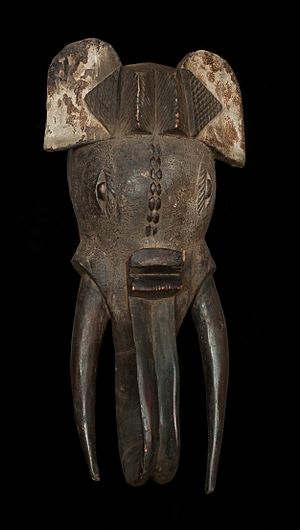
In 2019, it became illegal to export wild African elephants to zoos around the world. However, there is an exception if moving them to zoos helps protect elephants in the wild. Before this, countries like Zimbabwe had captured and sent over 100 baby elephants to Chinese zoos since 2012.
Research has shown that protecting elephants also helps fight climate change. Even though animals can reduce woody plants, they help store carbon in the soil.
Elephants in Culture
Many African cultures see the African elephant as a symbol of strength and power. It is also admired for its size, long life, endurance, intelligence, willingness to cooperate, and loyalty. Its religious importance is often related to totems. Many societies believed that their chiefs would be reborn as elephants. In the 10th century, the people of Igbo-Ukwu in Nigeria buried their leaders with elephant tusks.
South Africa uses elephant tusks in their coat of arms. They represent wisdom, strength, balance, and eternity.
In the western African Kingdom of Dahomey, the elephant was linked to the 19th-century rulers of the Fon people, Guezo and his son Glele. The animal was believed to show strength, royal history, and lasting memory. Their flag showed an elephant wearing a royal crown.
National Symbols
- The coat of arms of the Central African Republic has an elephant head.
- The coat of arms of Guinea (used from 1958 to 1984) had a golden elephant.
- The coat of arms of Ivory Coast features an elephant head.
- The coat of arms of the Republic of the Congo has two elephants supporting the shield.
- The coat of arms of Eswatini has an elephant and a lion supporting the shield.
Images for kids
See Also
 In Spanish: Elefantes africanos para niños
In Spanish: Elefantes africanos para niños



